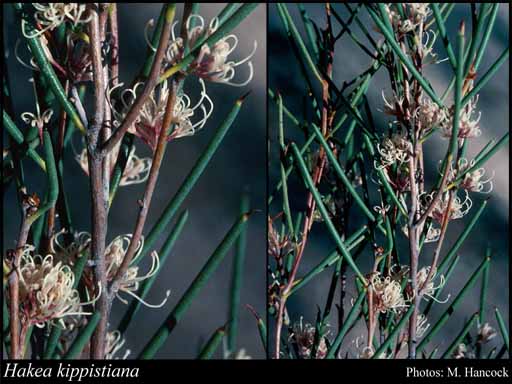- Reference
- Hooker's J.Bot.Kew Gard.Misc. 7:115 (1855)
- Conservation Code
- Not threatened
- Naturalised Status
- Native to Western Australia
- Name Status
- Current
Shrub, 1-4.5 m high. Fl. white & cream & pink, Sep or Nov. Red sand, laterite.

Scientific Description
Trees or Shrubs, 1-5 m high; branchlets hairy. Leaves alternate, (25-)30-80 mm long, 1-1.5 mm wide, glabrous; lamina terete, entire. Inflorescences axillary, white; pedicels 3-4 mm long. Perianth 3-5 mm long, glabrous; ovary glabrous; pistil 7-8 mm long, pollen presenter oblique, style glabrous. Follicles 19-25 mm long, 7-12.5 mm wide, corky tetrahedral projections (on external surfaces of fruit) absent; seed 14-16.5 mm long (including wing), 6-7 mm wide, the wing discontinuous, marginal, extending down one lateral side only. Flowers in January, February, November or December. Occurs in the Eremaean (ER) or South-west (SW) Botanical Province(s), in the Gibson Desert (GD), Murchison (MUR), Coolgardie (COO), Nullarbor (NUL), Avon Wheatbelt (AW), Jarrah Forest (JF) or Mallee (MAL) IBRA subregion(s).
Distribution
- IBRA Regions
- Avon Wheatbelt, Coolgardie, Jarrah Forest, Mallee, Murchison, Nullarbor.
- IBRA Subregions
- Carlisle, Eastern Goldfield, Eastern Mallee, Eastern Murchison, Katanning, Merredin, Southern Cross, Southern Jarrah Forest, Western Mallee.
- Local Government Areas (LGAs)
- Beverley, Bruce Rock, Coolgardie, Corrigin, Cranbrook, Cunderdin, Esperance, Kalgoorlie-Boulder, Kent, Kondinin, Menzies, Merredin, Wyalkatchem, Yilgarn.